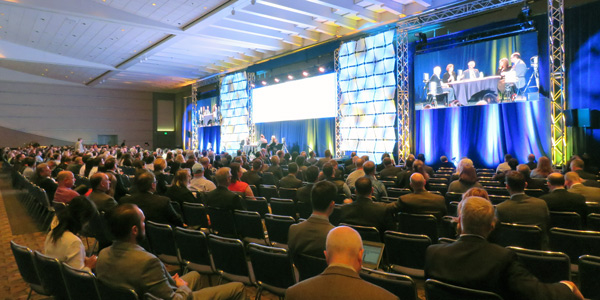By Jason Fordney
SACRAMENTO, Calif. — CAISO’s Board of Governors last week provided insight into a new 2030 energy “vision” for California and the region, one of many discussions at the ISO’s 2017 Stakeholder Symposium.

CAISO’s Symposium 2017 attracted about 1000 attendees. | © RTO Insider
Governor David Olsen said the “Electricity 2030” paper examines the “the sustained, orderly retirement of gas turbines.” It also discusses the importance of states working together and collaboration among agencies and the public.
CAISO is taking comments on the document, which says a decarbonized, decentralized and more regional electric grid is driving the transition in California. The paper calls for a grid powered by two-thirds non-fossil fuel — and no nuclear — generation by 2030, and lists economic benefits from clean energy jobs and better public health.
But operational dispatch to meet locational capacity needs will be different on a decentralized grid, and “there are engineering challenges along the way” to incorporate the combined capabilities of new resources such as solar and distributed generation, Olsen said.
“It is very important for all of us to take these challenges seriously,” he said, “because nothing will stop movement toward a modernized grid faster than a blackout.”
Challenge and Opportunity
NRG Energy last week took steps to withdraw its application for a new natural gas plant in Ventura County to replace 2,000 MW of generation retiring because of the state’s once-through cooling rules. (See NRG Signals Pull-out on Proposed Puente Plant.) The Ventura/Moorpark load pocket is one example of how locational needs require massive capital investment, as costs for the three distributed energy options to replace the capacity range from $309 million to $1.1 billion.
Governor Angelina Galiteva said the shift to a new type of grid is inevitable and discussed what she called the “financial justice” of the transition. Managing renewable integration “is a challenge, but it is also an opportunity,” she said.

Left to right: moderator John Danner, UC Berkeley-Haas & Princeton University; CAISO Board Members Richard Maullin, Chair; Angelina Galiteva; Mark Ferron; David Olsen | © RTO Insider
“We tend to agree that moving towards a much more decarbonized grid is where everybody is moving,” Galiteva said. A diversity of resources is important to optimize the system, meaning that interstate cooperation to optimize resources “becomes increasingly important.”
She added that climate change is a global issue, and developing countries will benefit from successful efforts in the U.S. “They can leapfrog technologies; they can build microgrids,” she said.
Governor Mark Ferron called for an “optimistic” attitude toward the emerging technology and new communications and called for a “forward-looking approach.”
“I kind of turn it around and say, ‘What’s the alternative?’” he said. “It is not a long-term winning strategy to try to restrict consumer choice or roll back new technology.” He also mentioned the “sea change” of integrating electric vehicles, which must become a grid asset and not a liability.
Regulators Discuss Regionalization
Montana Public Service Commission Vice Chair Travis Kavulla moderated a panel of state regulators who discussed regional differences and the effort to regionalize the Western electricity grid, which is expected to be resumed by the California State Legislature next January.

Left to right: David Danner, Chair, Washington UTC; Libby Jacobs, President, The Jacobs Group and former Iowa Utilities Board Chair; Michael Picker, President, California PUC; Dr. Laura Nelson, Energy Advisor, State of Utah; Travis Kavulla, Vice-Chair, Montana Public Service Commission | © RTO Insider
“There are a variety of cultural issues these days,” California Public Utilities Commission President Michael Picker said, adding that, aside from political differences in California, “we have a long-standing fear of FERC.” He predicted there will be some flexibility in terms of governance of an RTO.
“We have this enormous advantage of having this great diversity of resources in the West,” Picker said, which makes electricity planning easier than planning in other sectors, such as water rights.
Giving the inland West perspective, Laura Nelson, energy adviser to the Utah Public Service Commission, said: “Regionalization is inevitable, but it is a very, very slow-moving ship.” There are political differences to contend with, she noted.

Left to right: Martha Guzman Aceves, Member, California PUC; Judith Schwartz, President, To the Point; Geof Syphers, CEO, Sonoma Clean Power; Dr. Felicia Federico, Executive Director, California Center for Sustainable Communities, UCLA | © RTO Insider
“In parts of the Rocky Mountain West, we really do have a different view of our resources,” she said, but “Utah has been engaged in those conversations.” Utah has traditionally used a lot of coal for generation but also has natural gas and is on track to increase its renewable penetration to 8%.
Most panelists agreed that the trend toward regionalization will increase with time, with the large and dynamic gathering in Sacramento perhaps representing a step toward that end, if all parties can be brought into sufficient alignment while keeping electricity affordable and reliable.


